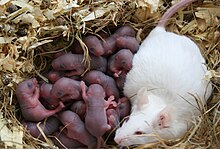r/K selection theory
A
North Atlantic right whale with solitary calf.
Whale reproduction follows a
K-selection strategy, with few offspring, long gestation, long parental care, and a long period until sexual maturity.
In
ecology,
r/K selection theory relates to the
selection of combinations of
traits in an organism that trade off between quantity and quality of offspring. The focus on either an increased quantity of offspring at the expense of individual
parental investment of
r-strategists, or on a reduced quantity of offspring with a corresponding increased parental investment of
K-strategists, varies widely, seemingly to promote success in particular environments. The concepts of quantity or quality offspring are sometimes referred to as "cheap" or "expensive", a comment on the expendable nature of the offspring and parental commitment made.
[1] The stability of the environment can predict if many expendable offspring are made or if fewer offspring of higher quality would lead to higher reproductive success. An unstable environment would encourage the parent to make many offspring, because the likelihood of all (or the majority) of them surviving to adulthood is slim. In contrast, more stable environments allow parents to confidently invest in one offspring because they are more likely to survive to adulthood.
The terminology of
r/
K-selection was coined by the ecologists
Robert MacArthur and
E. O. Wilson in 1967
[2] based on their work on
island biogeography;
[3] although the concept of the evolution of life history strategies has a longer history
[4] (see e.g.
plant strategies).
The theory was popular in the 1970s and 1980s, when it was used as a
heuristic device, but lost importance in the early 1990s, when it was criticized by several empirical studies.
[5][6] A
life-history paradigm has replaced the
r/
K selection paradigm but continues to incorporate many of its important themes.
[7]
Contents
Overview

A litter of mice with their mother. The reproduction of mice follows an
r-selection strategy, with many offspring, short gestation, less parental care, and a short time until sexual maturity.
In
r/
K selection theory, selective pressures are
hypothesised to drive
evolution in one of two generalized directions:
r- or
K-selection.
[2] These terms,
r and
K, are drawn from standard ecological
algebra as illustrated in the simplified
Verhulst model of
population dynamics:
[8]
d N d t = r N ( 1 − N K ) {\displaystyle {\frac {dN}{dt}}=rN\left(1-{\frac {N}{K}}\right)}
where
N is the
population,
r is the maximum
growth rate,
K is the
carrying capacity of the local environment, and
dN/dt, the
derivative of
N with respect to time
t, is the rate of change in population with time. Thus, the equation relates the growth rate of the population
N to the current population size, incorporating the effect of the two constant parameters
r and
K. (Note that decrease is negative growth.) The choice of the letter
K came from the
German Kapazitätsgrenze (capacity limit), while
r came from
rate.
r-selection
r-selected species are those that emphasize high growth rates, typically exploit less-crowded
ecological niches, and produce many
offspring, each of which has a relatively low probability of surviving to adulthood (i.e., high
r, low
K).
[9] A typical
r species is the dandelion (genus
Taraxacum).
In unstable or unpredictable environments,
r-selection predominates due to the ability to
reproduce rapidly. There is little advantage in adaptations that permit successful competition with other organisms, because the environment is likely to change again. Among the traits that are thought to characterize
r-selection are high
fecundity, small
body size, early maturity onset, short
generation time, and the ability to
disperse offspring widely.
Organisms whose life history is subject to
r-selection are often referred to as
r-strategists or
r-selected. Organisms that exhibit
r-selected traits can range from
bacteria and
diatoms, to
insects and
grasses, to various
semelparous cephalopods and small
mammals, particularly
rodents.
K-selection

A
bald eagle, an individual of a typical
K-strategist species.
K-strategists have longer life expectancies, produce fewer offspring and tend to be
altricial, requiring extensive care by parents when young.
By contrast,
K-selected species display traits associated with living at densities close to carrying capacity and typically are strong competitors in such crowded niches, that
invest more heavily in fewer offspring, each of which has a relatively high probability of surviving to adulthood (i.e., low
r, high
K). In
scientific literature,
r-selected species are occasionally referred to as "opportunistic" whereas
K-selected species are described as "equilibrium".
[9]
In stable or predictable environments,
K-selection predominates as the ability to
compete successfully for limited resources is crucial and populations of
K-selected organisms typically are very constant in number and close to the maximum that the environment can bear (unlike
r-selected populations, where population sizes can change much more rapidly).
Traits that are thought to be characteristic of
K-selection include large body size, long
life expectancy, and the production of fewer offspring, which often require
extensive parental care until they mature. Organisms whose life history is subject to
K-selection are often referred to as
K-strategists or
K-selected.
[10] Organisms with
K-selected traits include large organisms such as
elephants,
humans, and
whales, but also smaller long-lived organisms such as
Arctic terns,
[11] parrots and
eagles.
Continuous spectrum
Although some organisms are identified as primarily
r- or
K-strategists, the majority of organisms do not follow this pattern. For instance, trees have traits such as longevity and strong competitiveness that characterise them as
K-strategists. In reproduction, however, trees typically produce thousands of offspring and disperse them widely, traits characteristic of
r-strategists.
[12]
Similarly,
reptiles such as
sea turtles display both
r- and
K-traits: although sea turtles are large organisms with long lifespans (provided they reach adulthood), they produce large numbers of unnurtured offspring.
The
r/
K dichotomy can be re-expressed as a continuous spectrum using the economic concept of
discounted future returns, with
r-selection corresponding to large discount rates and
K-selection corresponding to small discount rates.
[13]








